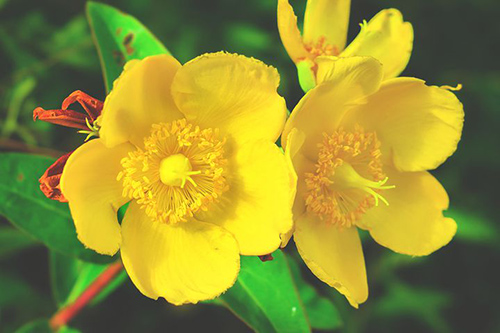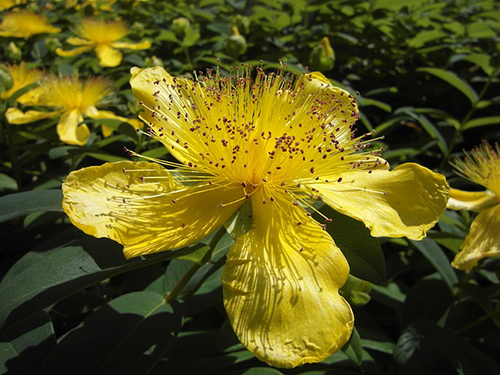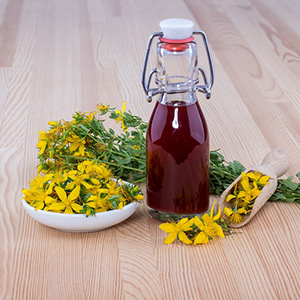Contents

The St. John’s wort plant is one of the many herbs known to the ancient world, a fame that has not decreased with time. Dioscorides during the first century A.D. praised this fantastic healing herb. Its Latin name comes from the Greek words hyper (upon) and eikon (image) since this plant is above anything else.
The St. John’s wort plant leaves are covered with small secreting bags, visible against the light, which look like small holes. Thus, the name perforatum. In the Renaissance, people supporting the theory of signs saw its “perforated but cicatrized” leaves as a sign that the plant should have wound-healing properties. In the 18th century, this plant was known as the “military plant” because soldiers valued it.
St. John’s wort is highly valued due to its wound-healing properties, and it has been used for thousands of years to treat burns. Moreover, we know that because of its stimulating and soothing properties, it is helpful for depression and other nervous disorders if taken in an infusion.
St. John’s Wort Plant Scientific Facts
- French: Herbe de Saint Jean
- Spanish: Hiperico, hierba de San Juan
- Environment: Spread worldwide, it is common in America and Europe. It grows in bushes, forests, untamed lands, and roadsides.
- Description: Vivacious plant on the Gutiferae family, growing from 30 to 60cm high, with an upright stem and leaves perforated by many holes, as if they were in rags. The flowers are yellow, with five petals each.
- Parts of the plant used medicinally: The flower clusters (leaves and flowers) and their oil.
Healing Properties and Warning

The leaves and flowers of the St. John’s wort plant contain essential oils, tannin, flavonoids, and a red coloring substance known as hypericin. St. John’s wort has the following properties:
- Wound healing, thanks to its tannin content and essence. When applied locally as oil, it presents exciting actions that make it a perfect remedy for bruises and wounds.
– It moderates the inflammatory reaction in the tissues surrounding the wound or bruise.
– It has local anesthetic properties, thus easing pain gently but persistently.
– It has antiseptic properties.
– It stimulates epithelization, that is, skin regeneration on the legion.
Hence, St. John’s wort has been used for over 2000 years to heal wounds, sores, and mainly burns.
It is more effective for 1st and 2nd-degree burns than most creams prepared from chemically synthesized products; we always recommend that a doctor prescribe a treatment for significant or deep burns.
When used internally, St. John’s wort has the following benefits:
- Balsamic and antispasmodic: It is recommended for asthma, bronchial catarrh, and bronchitis.
- Digestive, cholagogue, and choleretic help digestion, decrease stomach acidity and promote gall bladder functions.
- Nervous system stabilizer and invigorator: Hypericin has a balancing effect on the nervous system, and it has been proven to help those people suffering from depression or neurosis. It is used for children’s enuresis.
St. John’s wort is an excellent blood purifier. Because of its expectorant properties, it treats various health concerns, such as bronchial and lung problems. It can also treat pain and tenderness in the spine, muscle pains, and bruises, uterine disorders, irregular menstruation, coughs, hysteria, bed-wetting, uterine and afterbirth aches, suppressed urine, boils, jaundice, dysentery, and diarrhea.
St. John’s wort should be taken as close to meals as possible. For external applications, steep the flowers in olive oil for two weeks and then apply. The oil extracted from this plant can be used for wounds, bruises, and other skin ailments, primarily sensitive ones. Additionally, the oil can be applied to swollen breasts, burns, ulcers, and tumors.
WARNING: St. John’s wort causes the skin to become light-sensitive. Lighter-skinned individuals will have to avoid strong sunlight and other ultraviolet light exposure to the area where they applied the herb. Tanning beds will have to be avoided as well. If you’re using the herb to treat depression, have a nutritionally focused doctor check its effectiveness after four to six weeks. Please do not use it simultaneously as antidepressant prescriptions or during pregnancy or lactating.
Infusion: Steep the leaves for five to fifteen minutes and take one ounce, up to one cup daily, when needed. Tincture: Ten to twenty drops as needed. Fluid Extract: Take ½ to one teaspoon as needed. Powder: Take five to ten #0 capsules (30 to 60 grains) as required.
Preparation and Use

People wanting to follow the traditional customs can prepare their own St. John’s wort plant oil in the following way, which is what the Spanish botanist Font Quer recommended:
Put 100g of flower clusters (the tip of the stems) recently gathered but already dry into a glass jar, and add 250g of good olive oil. Steep in cold extract for 20 or 30 days, moving the bottle daily. After this time, strain the oil and bottle it in small containers, which must be kept in a cool, shady place, well sealed. When one of these bottles is open, discard the unused oil because it will lose its properties.
DISCLAIMER: All content on this website is presented solely for educational and informational objectives. It would be best to not rely on the information provided as a replacement for advice, diagnosis, or treatment from a qualified medical expert. If you are pregnant, nursing, or have any preexisting medical concerns, you should talk to your doctor before using any herbal or natural medicines.
REFERENCES
- George D. Pamplona-Roger, M.D. “Encyclopedia of Medicinal Plants.” George D. Pamplona-Roger, M.D. Encyclopedia of Medicinal Plants. Ed. Francesc X. Gelabert. vols. 2 San Fernando de Henares: Editorial Safeliz, 2000. 714,715. Print.
- Vance Ferrell Harold M. Cherne, M.D. The Natural Remedies Encyclopedia [Book]. – Altamont, TN: Harvestime Books, 2010. – Vol. Seventh Edition: 7: pp. 181, 182.
